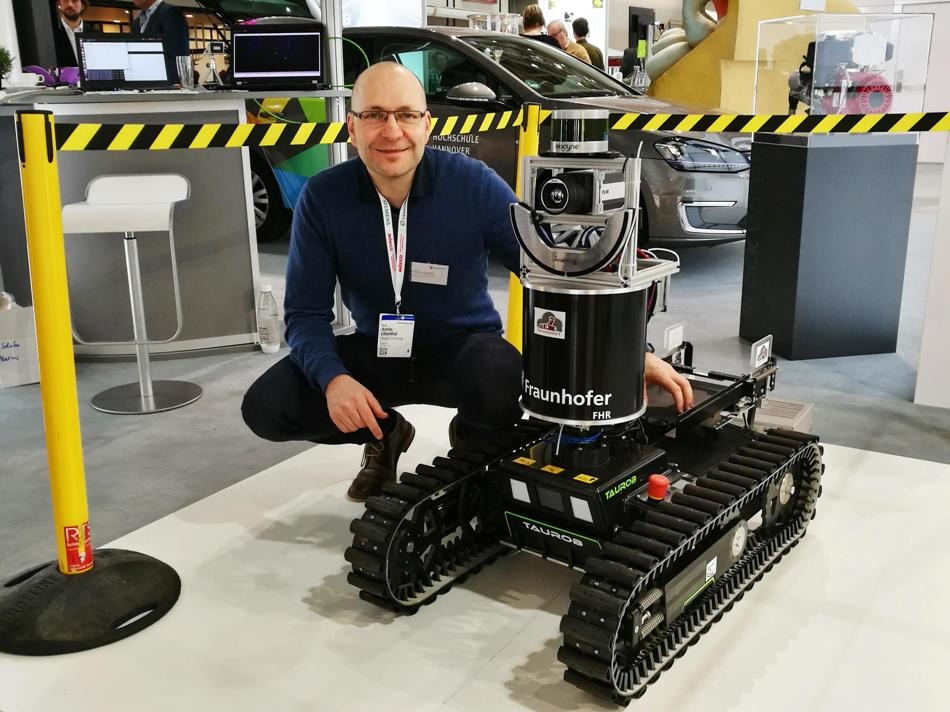Jun 21 2018
SmokeBot, the EU-funded research project headed by Örebro researcher Achim Lilienthal, gave way to a special kind of robot that not only views and navigates in smoke-filled areas but also detects gas leaks and plots maps of areas it has been in.
 Achim Lilienthal and SmokeBot. (Image Credit: Örebro University)
Achim Lilienthal and SmokeBot. (Image Credit: Örebro University)
The robot, SmokeBot, was primarily developed to help rescue units and fire services in deployments under crucial conditions. It effectively enhances the safety of rescue operations by collecting data about disasters and accident situations that have very limited visibility.
This robot is completely unique. It is equipped with gas sensors, radar, a laser scanner and thermal camera. At present, there is no robot with this combination of features.
Achim Lilienthal, Project Coordinator and Professor of Computer Science at Örebro University
SmokeBot Sees in Smoke-Filled Areas
This unique robot was designed in close association with rescue units based in Dortmund, Germany. The aim was to develop a robot that is adapted to the needs of rescue personnel during dangerous missions. By plotting maps of dust or smoke-filled areas, the robot provides a useful picture of an area which otherwise cannot be seen by humans.
Restricted visibility is particularly critical for our rescue units and affects our perception capacity. In such ‘blind situations’ SmokeBot can function as our eyes and lead us in search and rescue operations.
Sylvia Pratzler-Wanczura, Principal Engineer at the Institute of Fire Service and Rescue Technology, in Dortmund.
In addition, gas sensors integrated into the robot can detect different types of gases and also give information regarding the concentration and quantity of gases.
“It compiles information from different sensors and can assess, depending on temperature and occurrence of a particular gas, if there is a risk of a gas explosion,” informs Achim Lilienthal.
While rescue personnel can control the smoke-seeing robot remotely, it can also navigate itself if required. The robot can easily connect itself to the Internet and hence it always remains in contact with its operator.
“Should it lose contact with rescue personnel, which can happen, the robot remembers where it last had an Internet connection and can navigate back to that location,” Achim Lilienthal explains.
Can Become a Part of Future Rescue Services
According to Sylvia Pratzler-Wanczura, SmokeBot can well become a part of rescue services in the future. In fact, rescue services in Vienna, Austria are already using a similar kind of robot, which is only fitted with a camera and robot arm.
“Most definitely. It is a considerable advantage in situations where it is too risky to send in rescue personnel or when we need to search through large areas as is the case with floods and forest fires,” she says.
During this time, the robot takes approximately 15 to 30 minutes to gather data on the accident site, which means it cannot be deployed yet to the most urgent of rescue missions.
In these time-critical situations, it’s far too time-consuming. If we have to search for injured persons in a burning building and visibility is null, then we have precious little time for a rescue operation. We can’t take time to let a robot search the building first.
Sylvia Pratzler-Wanczura.
Multiple Areas of Application
While SmokeBot was mainly developed by researchers for use in various rescue operations, its various functions may pave the way for new areas of application as well as additional development of its numerous sensors.
“Another potential area where the robot could be of benefit is in agriculture. Here there is already a demand for robots that can see through dust. Gas sensors may also be used for measuring different kinds of gas emissions,” states Achim Lilienthal.